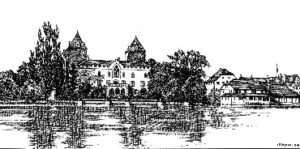Introduction Timeline Early Life Stance Schism Controversy Exile Council of Constance Legacy Persons/Events Medals Overview Bibliography
A REFORMER EXILED
When the leaders of the church excommunicated Jan Hus, many of his followers were angered and riots broke out. Hus faced exile and was forced to go into hiding in 1412. He spent much of his time writing letters, treatises, and hymns, as well as translating the Bible into the Bohemian language. One of his most famous treatises was De ecclesia (The Church). The time of Hus’ exile was brought to an end by the Council of Constance. Desiring a resolution to the Papal Schism, King Sigismund called for the church council to take place in November 1414. The council was also to make a decision about the supposed heresy of Hus in following Wycliffe. Despite the safe passage King Sigismund granted, Hus left Bohemia expecting he could be going to his death. Hus left the Prague area for the first time in his life, and after a three-week-long journey arrived in Constance on November 3.

One of the locations of Jan Hus’ imprisonment in Constance.
(Image found in “Pope John the Twenty-Third” by Eustace J. Kitts)
“You may perhaps not see me in Prague before I die; if, however, the Almighty God should be pleased to bring me back to you, we shall meet each other more joyfully. Furthermore, we shall, of course, meet one another in the heavenly joy.”
From a letter Hus wrote to his parishioners while journeying to Constance, October 19, 1414, translated in Matthew Spinka, The Letters of John Hus.


